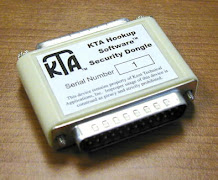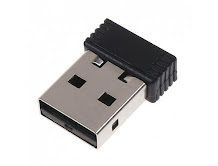Dongle (pronounced dong-guhl)
(1) Historically,
a hardware device attached to a computer without which a particular software
program will not run; used to prevent unauthorized use.
(2) Latterly,
a device (almost always plugged into a USB port) to enable connectivity with
other devices, peripherals or networks.
(3) In (very) casual use, any small USB device.
1980: First
recorded in 1980, shortly after the debut of the original IBM PC-1 and although
often cited as arbitrary coinage, is possibly derived from dangle, given the first dongles dangled from a short cable. Unfortunately, the advertisement in a
computer magazine in the early 1990s which claimed the dongle was invented by
an engineer named Don Gall was just an attempt to make nerds laugh and maybe
create an urban legend. Donglegate was a 2013 incident at an IT conference when a double entendre on the word "dongle" led to a complaint. Dongle is a noun; the noun plural is dongles. Because of the nature of the devices and the use to which they're put, it's surprising it seems not to be used as a verb; nor have dongling & dongled emerged.
Parallel-port dongle.
Historically, a dongle was a
small (about the size of a box of matches) pass-through device, a piece of
hardware which connected to a PC’s 25-pin parallel (then used most often for a printer) port. It provided usually a form of copy protection
and license enforcement in that the software with which it was supplied
wouldn’t run unless dongle was plugged-in.
Most PCs had only one printer port (although from the original IBM PC-1 (1981),
there was always support for three physical parallel ports and in the early days of the industry it wasn't unknown to see three Epson 9-pin impact (dot-matrix) clattering away, hanging off the one PC) but it was in some cases possible to
daisy-chain multiple dongles on the one port and still connect the actual
printer (as the last device in the chain). The
parallel dongles were famously robust and reliable but less successful were the
early implementations of dongles as USB devices; the problems were not solved until the early
2000s.
Raspberry Pi Nano WiFi dongle.
Dongle has also come to mean just about anything small which connects to a USB port and does something. Although the definitions were never codified, the convention of use with USB devices seems to be that a dongle is something which in some way is an enabling device for something else (such as connecting to a WAN, LAN, Wi-Fi or a streaming feed) whereas “stick”, “pen-drive” or “key” is used for something self-contained such as a flash drive.
Personalized dongles.
The most familiar “dongles are still the USB flash drives, used for data storage and file transfer, the later a large-scale version of the original “sneaker-net” which described a kind of low-tech “networking” of devices, accomplished by a programmer (wearing sneakers of course), floppy diskettes in hand, waling between machines to copy and write files. Memories fade but it’s not forgotten just how transformative was the arrival of the USB flash drive. Although there had been advances in removable storage which meant at least some users were no longer subject to the tyranny of the 1.44 MB floppy diskette, the proprietary devices were expensive and thus relatively rare. Additionally, the removable media depended on compatible devices existing at each end, something not always possible conveniently to arrange. On the PCS, the ubiquitous 3½ floppy diskette had shrunk from it 5¼-inch origins but grown from a capacity 180 KB to 1.44 MB and some versions in the 1990s supported 1.8 MB & 2.88 MB but take-up was slow, the BIOS (Basic Input-Output System) support needed by the latter attracting little support from manufacturers. Thus the enthusiasm which greeted the early 16 MB USB flash drives early in the century too grew to the point that in 2024 2 TB sticks are available and 4 TB prototypes have been demonstrated. That process also attracted the interest of economists who noted that even by the standards of IT hardware, the unit cost reductions have been dramatic: the early 1 GB sticks were advertised at US$300 yet by 2024 1 TB (1024 or 1000 GB depending on manufacturer) were advertised at under US$150. Curiously (and unusually for the industry), just who “invented” the USB flash drive remains contested.
Rainbow Technologies' "Don Gale" dongle advertisement (1992). While there was no actual Mr Gale, the story related is exactly the reason the software protection hardware was created.




No comments:
Post a Comment